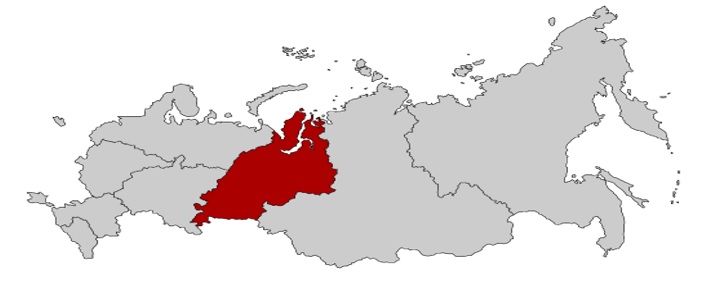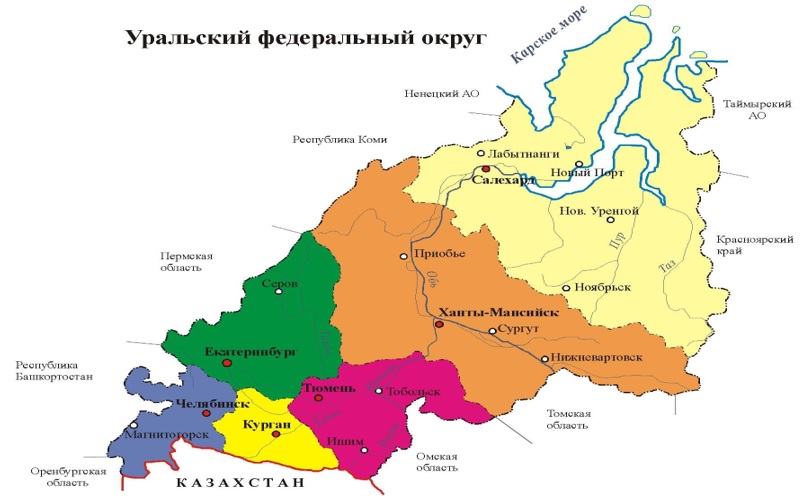Information about the consular district

The Urals Federal District of the Russian Federation (UrFO) was established on May 13, 2000.
Geography: The District is located on the border of the European and Asian subcontinents. The total area of the territory is 1818.49 thousand square kilometers (10.62% of the area of the Russian Federation). The district borders with the Republic of Kazakhstan, Volga, North-Western, Siberian districts. In the north, it has maritime borders. The nature of the Urals is characterized by the predominance of coniferous forests in the south and tundra in the north. The largest river in the Urals Federal District is the Ob. In the west of the district are the Ural Mountains.
Climate: The climate of the Ural District is continental, with long and cold winters and moderately warm summers. In the Southern and Middle Urals, winter temperatures can drop to -20, -30 degrees Celsius. The northern territories of the district are characterized by Arctic and subarctic climate with an average January temperature of -30 degrees Celsius and an average July temperature of +8 degrees Celsius.
Composition: The Urals Federal District includes 6 subjects of the Russian Federation: 4 regions (Sverdlovsk, Chelyabinsk, Kurgan, Tyumen) and 2 autonomous districts (Khanty-Mansiysk-Yugra, Yamalo-Nenets). The administrative center of the Urals Federal District is the city of Yekaterinburg.
Population: The total population of the Urals Federal District in 2023 is 12,255,848 (8.3% of the population of the Russian Federation), including 4,239,311 in the Sverdlovsk Oblast, 3,406,371 in the Chelyabinsk Oblast, 1,729,472 in the Khanty-Mansi Autonomous Okrug - Yugra, 1,607,274 in the Tyumen Oblast, 761,546 in the Kurgan Oblast, and 511,874 in the Yamalo-Nenets Autonomous Okrug. The population density is 6.76 people per square kilometer. 81.9% of the region's population are city dwellers. The largest cities of the Urals Federal District are Yekaterinburg, Chelyabinsk, Tyumen, Magnitogorsk, Surgut, Nizhny Tagil, Kurgan, Nizhnevartovsk, Kamensk-Uralsky, and Zlatoust. Representatives of more than 120 ethnic groups live in the Urals Federal District, representatives of more than 40 religious denominations are active, and more than 1,300 religious associations are registered.
Natural resources: The Urals Federal District is one of the most mineral-rich districts in Russia. Most regions of the district have mineral deposits. Gas and oil are produced in the autonomous okrugs. In these subjects, 66% of oil reserves and 77% of gas reserves of the Russian Federation are concentrated. There are lignite coal reserves in the south.
The district has significant reserves of iron, titanomagnetite, and copper ores, non-ferrous, noble, and rare metals, peat, asbestos, non-metallic building materials, precious and semi-precious stones. The district ranks third in Russia in terms of forest cover, with 10% of the country's forest plantations. The forests of the Ural District are rich in fur and hoofed animals, brown bear, and waterfowl.
Peculiarities of the economy and industry: The Urals Federal District is located between Europe and Asia, therefore the shortest route of trade and cargo turnover between the two parts of the world passes through its territory. The Urals Federal District ranks third in the country in terms of gross regional product (about 13% of the total).
Oil and gas industries account for more than 50% of the district's industry. The main oil and gas production enterprises are concentrated in YaMAO and KhMAO. The second place after the oil industry is occupied by the metallurgical industry (20% of the total output of the Urals Federal District), where iron ores are extracted and enriched, steel and pig iron are smelted. Almost half of the total volume of finished rolled products in the Russian Federation is produced in the Urals. The district's ferrous metallurgy uses not only its own ores but also imported ores. The largest ferrous metallurgy plants are located in Chelyabinsk, Nizhny Tagil, and Magnitogorsk. Non-ferrous metallurgy in the district is mainly represented by copper and aluminum production.
The Urals Federal District is home to machine-building enterprises producing machine tools and tools for transportation, energy, agricultural, and other industries. The Chelyabinsk Region specializes in the production of tractors, automobiles, construction, road and mining equipment, instrumentation, and machine tools; the Sverdlovsk Region in the production of power, transport, and chemical equipment; the Kurgan Region in agricultural, chemical, and printing machine building. A large number of enterprises of the military-industrial complex are also present in the Okrug. The chemical industry of the Ural Okrug operates on its own raw material base. Nitrogen and phosphate fertilizers, plastics, synthetic resins are produced here.
The district's power industry is represented by Surgut GRES-1 and GRES-2, Urengoyskaya and Nizhnevartovskaya GRES in the Tyumen Region, Reftinskaya GRES, Sredneuralskaya, Serovsky, Nizhneturinskaya GRES in the Sverdlovsk Region, and Yuzhno-Uralskaya GRES in the Chelyabinsk Region. The Beloyarskaya nuclear power plant - with a powerful fast neutron reactor - also operates in the Urals.
The agricultural lands of the county are mainly pastures and hayfields. In addition, the county is provided with water resources; it has a large number of rivers and lakes. The water bodies of the county have good fish productivity.
The specialization of the agro-industrial complex of the UrFO is grain (spring wheat, rye, oats) and livestock products (milk, meat, wool). Reindeer breeding and fur farming are developed in the northern regions of the Tyumen Oblast, and sheep breeding is developed in the southeastern part of the Kurgan Oblast. The food industry is represented by flour mills, dairy plants, and meat processing plants.
Transportation plays a huge role in the functioning of the economic complex of the Urals Federal District. The region is dominated by railway transport, which has both intra-regional and transit importance. The Trans-Siberian Railway runs through the territory of the Okrug. Well-known oil pipelines such as Nizhnevartovsk - Anzhero-Sudzhensk - Irkutsk, Surgut - Polotsk, Nizhnevartovsk - Ust-Balyk - Omsk, gas pipelines Urengoy - Pomary - Uzhgorod, Urengoy - Chelyabinsk originate in the territory of the Okrug. The main positions in the structure of exports from the Urals are occupied by oil and gas, followed by products of metallurgy, machine building, chemical, and forestry complexes; in the structure of imports - goods of the light industry, food industry, medicines, machinery and equipment, ores, and concentrates.
Significant forest resources of the region form the timber industry complex of the Urals Federal District. The Sverdlovsk Region is home to the most important centers of timber, woodworking (Serov, Severouralsk, Verkhoturye), and pulp and paper industries (Novaya Lyalya). Production of sawn timber, particle boards, glued plywood, factory-made wooden houses, heat-insulating, finishing, and other materials, wood products, furniture has been established. Timber processing is carried out in the cities of Tyumen, Salekhard, Tobolsk, Surgut, and Nizhnevartovsk.
